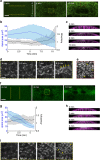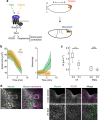Actomyosin meshwork mechanosensing enables tissue shape to orient cell force
- PMID: 28504247
- PMCID: PMC5440693
- DOI: 10.1038/ncomms15014
Actomyosin meshwork mechanosensing enables tissue shape to orient cell force
Abstract
Sculpting organism shape requires that cells produce forces with proper directionality. Thus, it is critical to understand how cells orient the cytoskeleton to produce forces that deform tissues. During Drosophila gastrulation, actomyosin contraction in ventral cells generates a long, narrow epithelial furrow, termed the ventral furrow, in which actomyosin fibres and tension are directed along the length of the furrow. Using a combination of genetic and mechanical perturbations that alter tissue shape, we demonstrate that geometrical and mechanical constraints act as cues to orient the cytoskeleton and tension during ventral furrow formation. We developed an in silico model of two-dimensional actomyosin meshwork contraction, demonstrating that actomyosin meshworks exhibit an inherent force orienting mechanism in response to mechanical constraints. Together, our in vivo and in silico data provide a framework for understanding how cells orient force generation, establishing a role for geometrical and mechanical patterning of force production in tissues.
Conflict of interest statement
The authors declare no competing financial interests.
Figures







Similar articles
-
Actomyosin-Driven Tension at Compartmental Boundaries Orients Cell Division Independently of Cell Geometry In Vivo.Dev Cell. 2018 Dec 17;47(6):727-740.e6. doi: 10.1016/j.devcel.2018.10.029. Epub 2018 Nov 29. Dev Cell. 2018. PMID: 30503752 Free PMC article.
-
Actomyosin-based tissue folding requires a multicellular myosin gradient.Development. 2017 May 15;144(10):1876-1886. doi: 10.1242/dev.146761. Epub 2017 Apr 21. Development. 2017. PMID: 28432215 Free PMC article.
-
Geometry can provide long-range mechanical guidance for embryogenesis.PLoS Comput Biol. 2017 Mar 27;13(3):e1005443. doi: 10.1371/journal.pcbi.1005443. eCollection 2017 Mar. PLoS Comput Biol. 2017. PMID: 28346461 Free PMC article.
-
Pulsation and stabilization: contractile forces that underlie morphogenesis.Dev Biol. 2010 May 1;341(1):114-25. doi: 10.1016/j.ydbio.2009.10.031. Epub 2009 Oct 27. Dev Biol. 2010. PMID: 19874815 Review.
-
The Mechanical Role of Microtubules in Tissue Remodeling.Bioessays. 2020 May;42(5):e1900244. doi: 10.1002/bies.201900244. Epub 2020 Apr 6. Bioessays. 2020. PMID: 32249455 Review.
Cited by
-
Combinatorial patterns of graded RhoA activation and uniform F-actin depletion promote tissue curvature.Development. 2021 Jun 1;148(11):dev199232. doi: 10.1242/dev.199232. Epub 2021 Jun 14. Development. 2021. PMID: 34124762 Free PMC article.
-
Hypothesis: Caco-2 cell rotational 3D mechanogenomic turing patterns have clinical implications to colon crypts.J Cell Mol Med. 2018 Dec;22(12):6380-6385. doi: 10.1111/jcmm.13853. Epub 2018 Sep 25. J Cell Mol Med. 2018. PMID: 30255651 Free PMC article.
-
Sculpting tissues by phase transitions.Nat Commun. 2022 Feb 3;13(1):664. doi: 10.1038/s41467-022-28151-9. Nat Commun. 2022. PMID: 35115507 Free PMC article. Review.
-
Pulsed actomyosin contractions in morphogenesis.F1000Res. 2020 Feb 25;9:F1000 Faculty Rev-142. doi: 10.12688/f1000research.20874.1. eCollection 2020. F1000Res. 2020. PMID: 32148766 Free PMC article. Review.
-
Mechanical control of neural plate folding by apical domain alteration.Nat Commun. 2023 Dec 20;14(1):8475. doi: 10.1038/s41467-023-43973-x. Nat Commun. 2023. PMID: 38123550 Free PMC article.
References
-
- Vignaud T. et al.. Reprogramming cell shape with laser nano-patterning. J. Cell Sci. 125, 2134–2140 (2012). - PubMed
-
- Théry M., Pépin A., Dressaire E., Chen Y. & Bornens M. Cell distribution of stress fibres in response to the geometry of the adhesive environment. Cell Motil. Cytoskeleton 63, 341–355 (2006). - PubMed
Publication types
MeSH terms
Substances
Grants and funding
LinkOut - more resources
Full Text Sources
Other Literature Sources
Molecular Biology Databases

